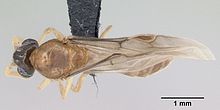- Adetomyrma
-
Adetomyrma 
a blind worker 
a winged queen Conservation status Scientific classification Kingdom: Animalia Phylum: Arthropoda Class: Insecta Order: Hymenoptera Family: Formicidae Subfamily: Amblyoponinae Tribe: Amblyoponini Genus: Adetomyrma
Ward, 1994[2]Species A. venatrix Ward, 1994
Adetomyrma is an endangered genus of ants endemic to Madagascar. Workers of this species are blind. The type species Adetomyrma venatrix was described in 1994, with the genus being an atypical member of its tribe. This tribe includes the dracula ants, members of which feed on the hemolymph of larvae.
Contents
Description
The species Adetomyrma venatrix was described on the basis of specimens belonging to the worker caste collected from Zombitse Forest, in western Madagascar. The key characteristics of the species was the absence of a clear petiole when viewed from above due to the third abdominal tergite (the sclerite on the dorsal side) lacking a differentiated pretergite. The gaster is large and without constrictions. The ant is blind and has a long sting. It was placed with reservations in the tribe Amblyoponini as it lacks the typical characters of the group.[3] Later studies considered them as being close to the ancestral members of the Amblyoponinae and they share certain morphological features with Amblyopone pluto such as the presence of laterosclerite.[4][5]
More species within the genus may exist but are yet to be described formally and classified.[6]
Biology
Members of the Amblyoponinae (especially Amblypone silvestrii) are called Dracula ants, after Count Dracula, the fictional vampire, referring to their unusual feeding habits; queens and workers practice a form of "non-destructive cannibalism", chewing holes into and feeding on the haemolymph (insect "blood") of the colony's own larvae. This behaviour, termed larval hemolymph feeding is thought to represent a precursor to trophallaxis, found in more derived ant species.[6][7]
The colonies, the first of which was found in a rotting log, may contain as many as 10,000 workers, winged males and several wingless queens (the majority of ant species feature winged queens). The workers use venom to stun their prey which are brought back to the colony for the larvae to feed upon. The colour of the winged males, a darker orange than the workers, suggests they disperse by flying to other colonies before mating.[2]
References
- ^ Social Insects Specialist Group (1996). Adetomyrma venatrix. In: IUCN 2008. IUCN Red List of Threatened Species. Downloaded on 10 May 2009.
- ^ a b Ward, P. S. (1994). "Adetomyrma, an enigmatic new ant genus from Madagascar (Hymenoptera: Formicidae), and its implications for ant phylogeny". Systematic Entomology 19 (2): 159–175. doi:10.1111/j.1365-3113.1994.tb00585.x. http://antbase.org/ants/publications/2959/2959.pdf.
- ^ Fisher, BL (1997). "Biogeography and ecology of the ant fauna of Madagascar (Hymenoptera: Formicidae)". Journal of Natural History 31 (2): 269–302. doi:10.1080/00222939700770141. http://research.calacademy.org/research/entomology/personnel/CVs/pdfs/BiogeographyandEcology1997.pdf.
- ^ Perrault, Gérard H. (2004). "Étude morphoanatomique et biométrique du métasoma antérieur des ouvrières. Contribution à la systématique et à la phylogénie des fourmis (Hymenoptera : Formicidae)" (in French). Ann. Soc. Entomol. Fr. 40 (3–4): 291–371. http://zoologie.umh.ac.be/asef/pdf/2004_40_03_04/compact/Perrault_ASEF_2004_40_1_4_291_371_compact.pdf.
- ^ Grimaldi, D; D Agosti; J M Carpenter. "New and Rediscovered Primitive Ants (Hymenoptera: Formicidae) in Cretaceous Amber from New Jersey, and Their Phylogenetic Relationships". American Museum Novitates 3208: 1–43. http://antbase.org/ants/publications/8419/8419.pdf.
- ^ a b Saux, Corrie; Brian L. Fisher; Greg S. Spicer (2004). "Dracula ant phylogeny as inferred by nuclear 28S rDNA sequences and implications for ant systematics (Hymenoptera: Formicidae: Amblyoponinae)". Molecular Phylogenetics and Evolution 33 (2): 457–468. doi:10.1016/j.ympev.2004.06.017. PMID 15336679. http://fm1.fieldmuseum.org/aa/Files/cmoreau/Saux_et_al._2004.pdf.
- ^ Masuko, K. (1986). "Larval hemolymph feeding: a non-destructive parental cannibalism in the primitive ant Amblyopone silvestrii Wheeler (Hymenoptera: Formicidae)". Behav. Ecol. Sociobiol. 19 (4): 249–255. doi:10.1007/BF00300639.
External links
Categories:- IUCN Red List critically endangered species
- Amblyoponinae
Wikimedia Foundation. 2010.


